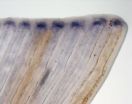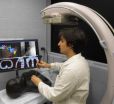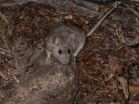(Press-News.org) The reason why some animals can regenerate tissues after severe organ loss or amputation while others, such as humans, cannot renew some structures has always intrigued scientists. In a study now published in PLOS ONE*, a research group from Instituto Gulbenkian de Ciência (IGC, Portugal) led by Joaquín Rodríguez León provided new clues to solve this central question by investigating regeneration in an adult vertebrate model: the zebrafish. It was known that zebrafish is able to regenerate organs, and that electrical currents may play a role in this process, but the exact mechanisms are still unclear. Using both biophysical and molecular approaches, the researchers have shown, for the first time, that zebrafish regenerates its caudal fin by a process that involves a specific channel in the cell membrane, called V-ATPase, that pumps hydrogen ions (H+) out of the cells generating an electrical current. Understanding these mechanisms underlying adult tissue regeneration may be instrumental for the development of new therapeutic strategies, both in regenerative and developmental medicine.
Cell regeneration is a biological feature of all living organisms with an important role in growth, wound healing, tissue repair and similar biological functions. Scientists have been investigating the molecular aspects that underline regeneration aiming to understand why some animals have the ability to regrow entire tissue structures after amputation or injury whereas humans can just regenerate few organs, such as the liver or the skin. The classical approach has been to look at genes and proteins, and only more recently, the relevance of bioelectric signals began to be investigated. Researchers from Joaquín Rodríguez León's laboratory set out to analyze the contribution of different ion fluxes in the cell membrane, either inwards or outwards, during regeneration in the zebrafish caudal fin. They discovered that only the transport of hydrogen ions or protons (H+) played a role in the regenerative process. The research team observed that this transport occurred via V-ATPase enzyme, that forms a channel in the cell membrane and pumps H+ out of the cell. The researchers discovered that the activity of this electric signal is necessary in different aspects of normal regeneration, namely for the expression of crucial genes, formation of a mass of cells capable of growth and regenerate, and proper tissue innervation. The researchers found that this electric current was also important to coordinate other proteins that could establish a positional memory to ensure the correct regeneration of the injured tissue.
Joaquín Rodríguez-León says: "Scientists use different strategies to unveil the mechanisms behind regeneration to apply this knowledge in the future clinical practice. Some teams are studying the potential of stem cells and others try to understand why some animals can regenerate. Our team contributes to understand how the cellular machinery, that is similar in all vertebrates, can regenerate a structure in an animal. Particular cellular machinery needs to be "switched on" and that is what we try to understand. Using the zebrafish as a model, we have found that an essential feature of cells, ion dynamics, contributes to the regeneration of limbs. Specifically, we have found that H+ (protons) actively contribute to create an electric current that is needed for proper regeneration."
INFORMATION:
This research was developed in collaboration with investigators from Instituto de Medicina Molecular, Centro de Estudos de Doenças Crónicas and Champalimaud Foundation. Joaquín Rodríguez-León is a Principal Investigator at the IGC and Faculdade de Medicina, Universidad de Extremadura (Spain). This research was funded by the Fundação para a Ciência e a Tecnologia (FCT; Portugal) and European Union.
* Monteiro, J, Aires, R, Becker, JD, Jacinto, A, Certal, AC, Rodríguez-León, J. (2014) V-ATPase Proton Pumping Activity Is Required for Adult Zebrafish Appendage Regeneration. PLoS ONE 9(3): e92594 doi:10.1371/journal.pone.0092594
To grow or not to grow: a step forward in adult vertebrate tissue regeneration
2014-03-27
ELSE PRESS RELEASES FROM THIS DATE:
Seasonal Arctic summer ice extent still hard to forecast, study says
2014-03-27
Scientists at the National Snow and Ice Data Centre (NSIDC), University College London, University of New Hampshire and University of Washington analysed 300 summer Arctic sea ice forecasts from 2008 to 2013 and found that forecasts are quite accurate when sea ice conditions are close to the downward trend that has been observed in Arctic sea ice for the last 30 years. However, forecasts are not so accurate when sea ice conditions are unusually higher or lower compared to this trend.
"We found that in years when the sea ice extent departed strongly from the trend, such ...
Four in 10 infants lack strong parental attachments
2014-03-27
PRINCETON, N.J.—In a study of 14,000 U.S. children, 40 percent lack strong emotional bonds — what psychologists call "secure attachment" — with their parents that are crucial to success later in life, according to a new report. The researchers found that these children are more likely to face educational and behavioral problems.
In a report published by Sutton Trust, a London-based institute that has published more than 140 research papers on education and social mobility, researchers from Princeton University, Columbia University, the London School of Economics and Political ...
GW researcher invents 'mini heart' to help return venous blood
2014-03-27
WASHINGTON (March 27, 2014) — George Washington University (GW) researcher Narine Sarvazyan, Ph.D., has invented a new organ to help return blood flow from veins lacking functional valves. A rhythmically contracting cuff made of cardiac muscle cells surrounds the vein acting as a 'mini heart' to aid blood flow through venous segments. The cuff can be made of a patient's own adult stem cells, eliminating the chance of implant rejection.
"We are suggesting, for the first time, to use stem cells to create, rather than just repair damaged organs," said Sarvazyan, professor ...
Clemson researcher touts surgical safety checklist to save lives
2014-03-27
Clemson University research assistant professor Ashley Kay Childers has been selected to participate in a forum to discuss quality improvement programs in U.S. hospitals that reduce preventable readmissions, prevent medical errors, improve patient outcomes and cut costs.
Childers, who also is a member of the South Carolina Hospital Association (SCHA) Quality and Patient Safety team, will participate in the American College of Surgeons (ACS) Surgical Health Care Quality Forum South Carolina in Columbia April 1.
The forum will focus on Childers' work with the Safe Surgery ...
Neurobiologists find chronic stress in early life causes anxiety, aggression in adulthood
2014-03-27
Cold Spring Harbor, NY -- In recent years, behavioral neuroscientists have debated the meaning and significance of a plethora of independently conducted experiments seeking to establish the impact of chronic, early-life stress upon behavior – both at the time that stress is experienced, and upon the same individuals later in life, during adulthood.
These experiments, typically conducted in rodents, have on the one hand clearly indicated a link between certain kinds of early stress and dysfunction in the neuroendocrine system, particularly in the so-called HPA axis (hypothalamic-pituitary-adrenal), ...
Cause for exaggerated insulin response in subset of bariatric surgery patients identified
2014-03-27
CINCINNATI—University of Cincinnati (UC) researchers have discovered that altered islet cell function and reduced insulin clearance contribute to excessive post-meal insulin response in patients experiencing low blood sugar symptoms (hypoglycemia) following gastric bypass surgery.
These findings, led by Marzieh Salehi, MD, associate professor in the UC division of endocrinology, metabolism and diabetes, are featured online this month in The Journal of Clinical Endocrinology & Metabolism, and are part of an ongoing effort by UC researchers to better understand the effect ...
NASA's Hubble Space Telescope spots Mars-bound comet sprout multiple jets
2014-03-27
NASA released Thursday an image of a comet that, on Oct. 19, will pass within 84,000 miles of Mars -- less than half the distance between Earth and our moon.
The image on the left, captured Mar. 11 by NASA's Hubble Space Telescope, shows comet C/2013 A1, also called Siding Spring, at a distance of 353 million miles from Earth. Hubble can't see Siding Spring's icy nucleus because of its diminutive size. The nucleus is surrounded by a glowing dust cloud, or COMA, that measures roughly 12,000 miles across.
The right image shows the comet after image processing techniques ...
New guidance system could improve minimally invasive surgery
2014-03-27
Johns Hopkins researchers have devised a computerized process that could make minimally invasive surgery more accurate and streamlined using equipment already common in the operating room.
In a report published recently in the journal Physics in Medicine and Biology, the researchers say initial testing of the algorithm shows that their image-based guidance system is potentially superior to conventional tracking systems that have been the mainstay of surgical navigation over the last decade.
"Imaging in the operating room opens new possibilities for patient safety and ...
Anti-clotting agent helps reduce the incidence and impact of stent thrombosis during PCI
2014-03-27
WASHINGTON, DC – March 27, 2014 –A new angiographic analysis of the CHAMPION PHOENIX trial examined the incidence and impact of stent thrombosis (ST) in patients undergoing percutaneous coronary intervention (PCI). Results of the study were released today and will be presented March 30 at the American College of Cardiology 63rd Annual Scientific Session.
CHAMPION PHOENIX was a prospective, double-blind, active-controlled trial which randomized 11,145 patients to receive intravenous cangrelor or oral clopidogrel administered at the time of PCI. In a previous analysis presented ...
A tale of 2 species
2014-03-27
A pair of new studies from the Wildlife Conservation Society, Idaho State University, and the University of Nevada Reno look at the surprising variety of factors that prevent two closely related species of woodrats from becoming a single hybrid species despite the existence of hybrid individuals where the two species come into contact.
After finding that two closely related species, the desert and Bryant's woodrats, could interbreed and produce hybrid offspring, scientists set out to determine why only 14 percent of the population in a "contact zone" had genetic signatures ...




